Principles of Psychology Report: Causes of Human Behavior and Learning
VerifiedAdded on 2023/06/04
|14
|4886
|165
Report
AI Summary
This report provides an overview of key concepts in psychology, focusing on human behavior, learning, and thinking. It defines psychology, discusses its development and research methods, and explores the causes of human behavior from various perspectives, including the neuroscientific perspective. The report examines factors that affect learning, covering behaviorist, cognitive, and humanist approaches. It also delves into how thinking takes place, including memory functions and problem-solving strategies, providing insights into encoding, storing, and retrieving information, as well as different types of rehearsals. The report also touches upon the application of psychology in business contexts, such as marketing and employee management, highlighting the influence of genetic and environmental factors, social norms, and cognitive behavior on individual actions. Additionally, it analyzes the role of neuroscience in understanding and improving human behavior, providing tools for addressing societal issues and enhancing business practices through neuromarketing and effective team dynamics.
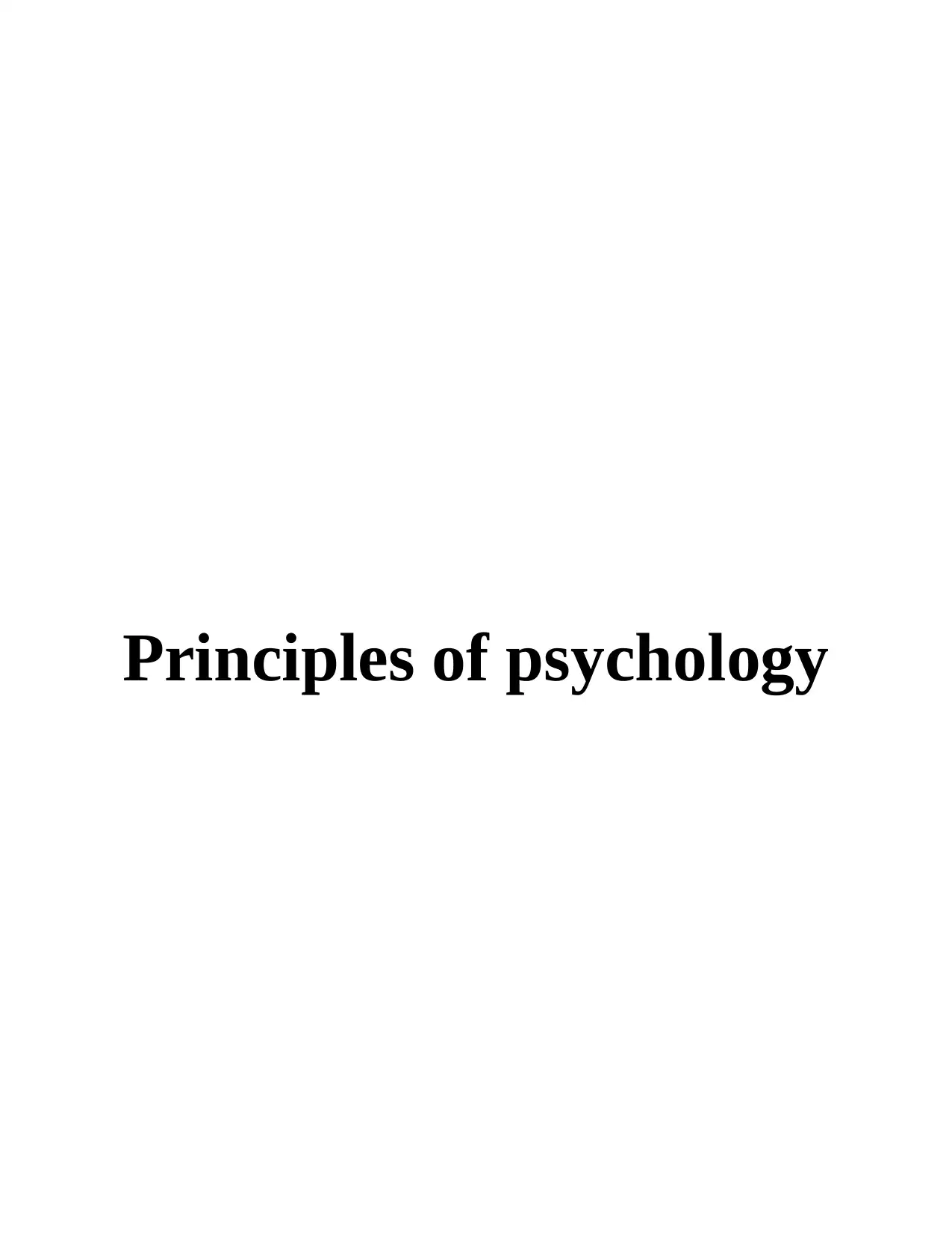
Principles of psychology
Paraphrase This Document
Need a fresh take? Get an instant paraphrase of this document with our AI Paraphraser
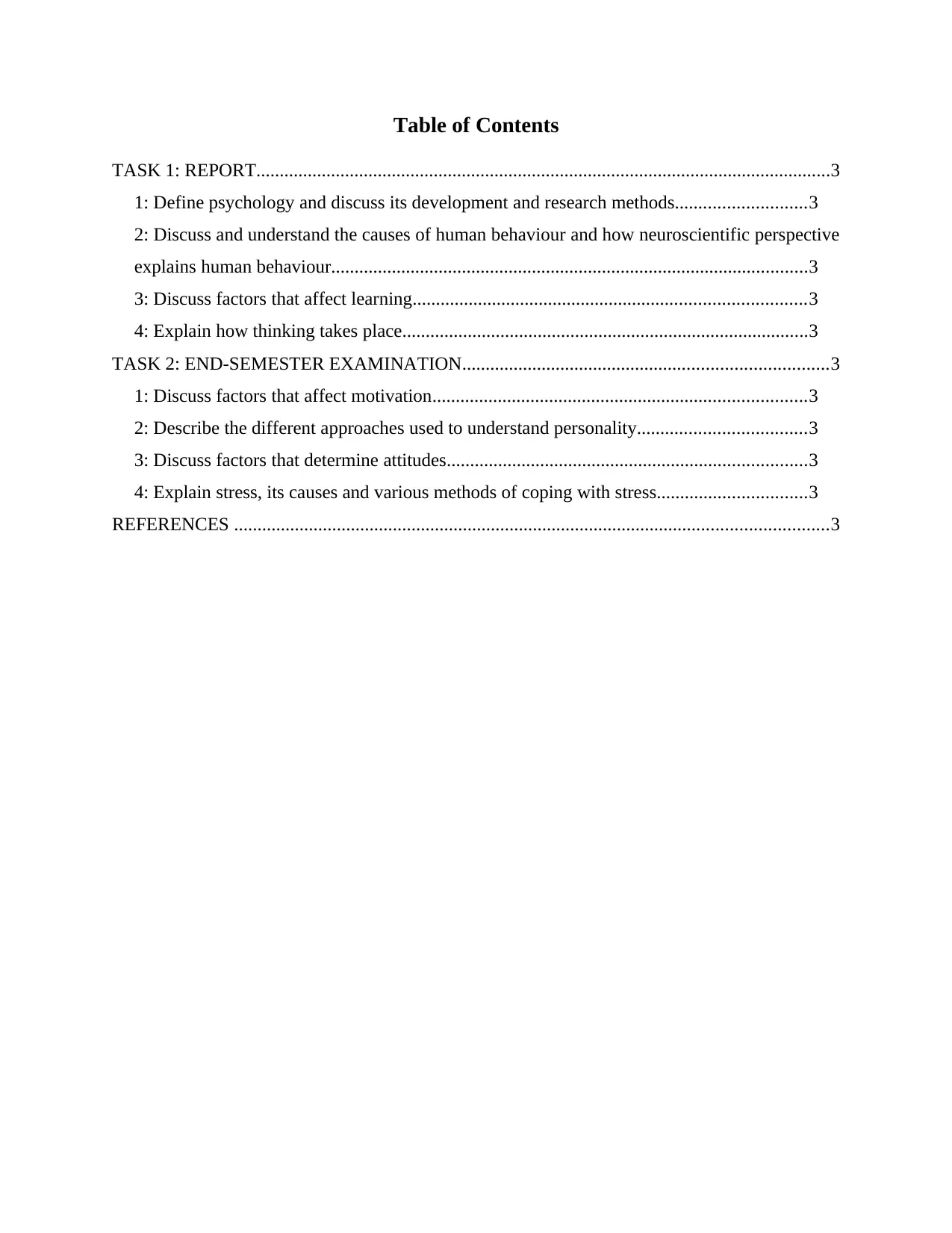
Table of Contents
TASK 1: REPORT...........................................................................................................................3
1: Define psychology and discuss its development and research methods............................3
2: Discuss and understand the causes of human behaviour and how neuroscientific perspective
explains human behaviour......................................................................................................3
3: Discuss factors that affect learning....................................................................................3
4: Explain how thinking takes place.......................................................................................3
TASK 2: END-SEMESTER EXAMINATION..............................................................................3
1: Discuss factors that affect motivation................................................................................3
2: Describe the different approaches used to understand personality....................................3
3: Discuss factors that determine attitudes.............................................................................3
4: Explain stress, its causes and various methods of coping with stress................................3
REFERENCES ...............................................................................................................................3
TASK 1: REPORT...........................................................................................................................3
1: Define psychology and discuss its development and research methods............................3
2: Discuss and understand the causes of human behaviour and how neuroscientific perspective
explains human behaviour......................................................................................................3
3: Discuss factors that affect learning....................................................................................3
4: Explain how thinking takes place.......................................................................................3
TASK 2: END-SEMESTER EXAMINATION..............................................................................3
1: Discuss factors that affect motivation................................................................................3
2: Describe the different approaches used to understand personality....................................3
3: Discuss factors that determine attitudes.............................................................................3
4: Explain stress, its causes and various methods of coping with stress................................3
REFERENCES ...............................................................................................................................3
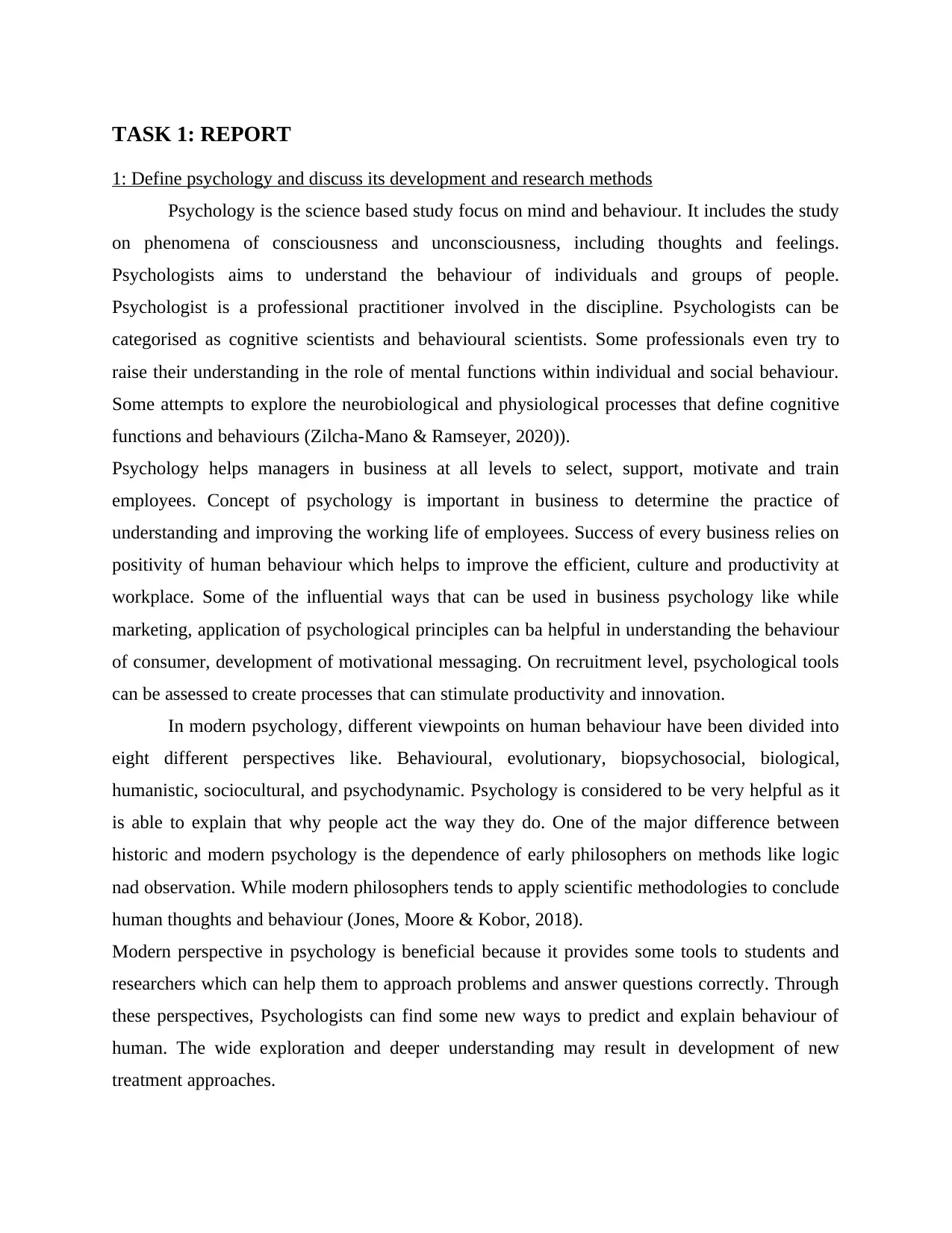
TASK 1: REPORT
1: Define psychology and discuss its development and research methods
Psychology is the science based study focus on mind and behaviour. It includes the study
on phenomena of consciousness and unconsciousness, including thoughts and feelings.
Psychologists aims to understand the behaviour of individuals and groups of people.
Psychologist is a professional practitioner involved in the discipline. Psychologists can be
categorised as cognitive scientists and behavioural scientists. Some professionals even try to
raise their understanding in the role of mental functions within individual and social behaviour.
Some attempts to explore the neurobiological and physiological processes that define cognitive
functions and behaviours (Zilcha-Mano & Ramseyer, 2020)).
Psychology helps managers in business at all levels to select, support, motivate and train
employees. Concept of psychology is important in business to determine the practice of
understanding and improving the working life of employees. Success of every business relies on
positivity of human behaviour which helps to improve the efficient, culture and productivity at
workplace. Some of the influential ways that can be used in business psychology like while
marketing, application of psychological principles can ba helpful in understanding the behaviour
of consumer, development of motivational messaging. On recruitment level, psychological tools
can be assessed to create processes that can stimulate productivity and innovation.
In modern psychology, different viewpoints on human behaviour have been divided into
eight different perspectives like. Behavioural, evolutionary, biopsychosocial, biological,
humanistic, sociocultural, and psychodynamic. Psychology is considered to be very helpful as it
is able to explain that why people act the way they do. One of the major difference between
historic and modern psychology is the dependence of early philosophers on methods like logic
nad observation. While modern philosophers tends to apply scientific methodologies to conclude
human thoughts and behaviour (Jones, Moore & Kobor, 2018).
Modern perspective in psychology is beneficial because it provides some tools to students and
researchers which can help them to approach problems and answer questions correctly. Through
these perspectives, Psychologists can find some new ways to predict and explain behaviour of
human. The wide exploration and deeper understanding may result in development of new
treatment approaches.
1: Define psychology and discuss its development and research methods
Psychology is the science based study focus on mind and behaviour. It includes the study
on phenomena of consciousness and unconsciousness, including thoughts and feelings.
Psychologists aims to understand the behaviour of individuals and groups of people.
Psychologist is a professional practitioner involved in the discipline. Psychologists can be
categorised as cognitive scientists and behavioural scientists. Some professionals even try to
raise their understanding in the role of mental functions within individual and social behaviour.
Some attempts to explore the neurobiological and physiological processes that define cognitive
functions and behaviours (Zilcha-Mano & Ramseyer, 2020)).
Psychology helps managers in business at all levels to select, support, motivate and train
employees. Concept of psychology is important in business to determine the practice of
understanding and improving the working life of employees. Success of every business relies on
positivity of human behaviour which helps to improve the efficient, culture and productivity at
workplace. Some of the influential ways that can be used in business psychology like while
marketing, application of psychological principles can ba helpful in understanding the behaviour
of consumer, development of motivational messaging. On recruitment level, psychological tools
can be assessed to create processes that can stimulate productivity and innovation.
In modern psychology, different viewpoints on human behaviour have been divided into
eight different perspectives like. Behavioural, evolutionary, biopsychosocial, biological,
humanistic, sociocultural, and psychodynamic. Psychology is considered to be very helpful as it
is able to explain that why people act the way they do. One of the major difference between
historic and modern psychology is the dependence of early philosophers on methods like logic
nad observation. While modern philosophers tends to apply scientific methodologies to conclude
human thoughts and behaviour (Jones, Moore & Kobor, 2018).
Modern perspective in psychology is beneficial because it provides some tools to students and
researchers which can help them to approach problems and answer questions correctly. Through
these perspectives, Psychologists can find some new ways to predict and explain behaviour of
human. The wide exploration and deeper understanding may result in development of new
treatment approaches.
⊘ This is a preview!⊘
Do you want full access?
Subscribe today to unlock all pages.

Trusted by 1+ million students worldwide
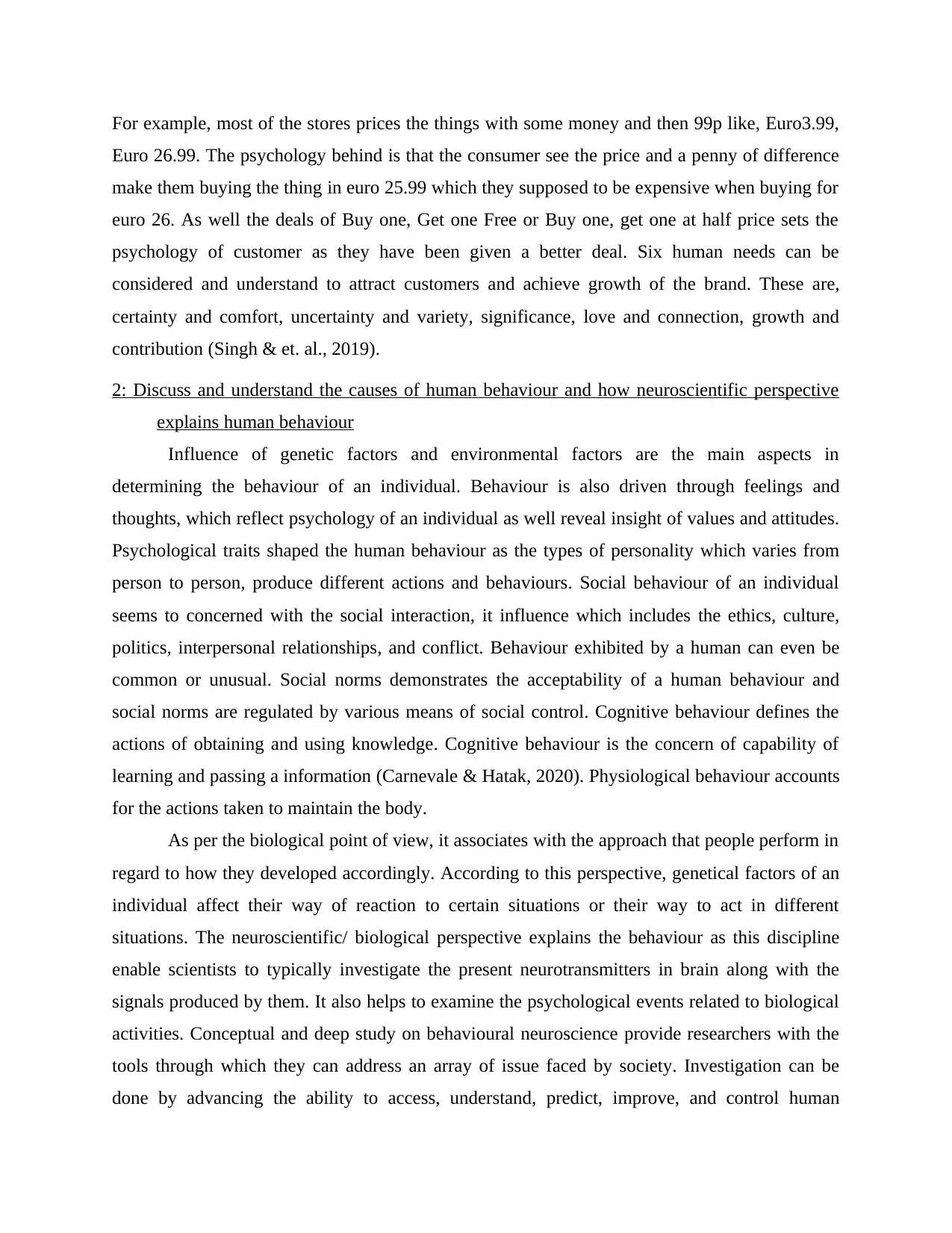
For example, most of the stores prices the things with some money and then 99p like, Euro3.99,
Euro 26.99. The psychology behind is that the consumer see the price and a penny of difference
make them buying the thing in euro 25.99 which they supposed to be expensive when buying for
euro 26. As well the deals of Buy one, Get one Free or Buy one, get one at half price sets the
psychology of customer as they have been given a better deal. Six human needs can be
considered and understand to attract customers and achieve growth of the brand. These are,
certainty and comfort, uncertainty and variety, significance, love and connection, growth and
contribution (Singh & et. al., 2019).
2: Discuss and understand the causes of human behaviour and how neuroscientific perspective
explains human behaviour
Influence of genetic factors and environmental factors are the main aspects in
determining the behaviour of an individual. Behaviour is also driven through feelings and
thoughts, which reflect psychology of an individual as well reveal insight of values and attitudes.
Psychological traits shaped the human behaviour as the types of personality which varies from
person to person, produce different actions and behaviours. Social behaviour of an individual
seems to concerned with the social interaction, it influence which includes the ethics, culture,
politics, interpersonal relationships, and conflict. Behaviour exhibited by a human can even be
common or unusual. Social norms demonstrates the acceptability of a human behaviour and
social norms are regulated by various means of social control. Cognitive behaviour defines the
actions of obtaining and using knowledge. Cognitive behaviour is the concern of capability of
learning and passing a information (Carnevale & Hatak, 2020). Physiological behaviour accounts
for the actions taken to maintain the body.
As per the biological point of view, it associates with the approach that people perform in
regard to how they developed accordingly. According to this perspective, genetical factors of an
individual affect their way of reaction to certain situations or their way to act in different
situations. The neuroscientific/ biological perspective explains the behaviour as this discipline
enable scientists to typically investigate the present neurotransmitters in brain along with the
signals produced by them. It also helps to examine the psychological events related to biological
activities. Conceptual and deep study on behavioural neuroscience provide researchers with the
tools through which they can address an array of issue faced by society. Investigation can be
done by advancing the ability to access, understand, predict, improve, and control human
Euro 26.99. The psychology behind is that the consumer see the price and a penny of difference
make them buying the thing in euro 25.99 which they supposed to be expensive when buying for
euro 26. As well the deals of Buy one, Get one Free or Buy one, get one at half price sets the
psychology of customer as they have been given a better deal. Six human needs can be
considered and understand to attract customers and achieve growth of the brand. These are,
certainty and comfort, uncertainty and variety, significance, love and connection, growth and
contribution (Singh & et. al., 2019).
2: Discuss and understand the causes of human behaviour and how neuroscientific perspective
explains human behaviour
Influence of genetic factors and environmental factors are the main aspects in
determining the behaviour of an individual. Behaviour is also driven through feelings and
thoughts, which reflect psychology of an individual as well reveal insight of values and attitudes.
Psychological traits shaped the human behaviour as the types of personality which varies from
person to person, produce different actions and behaviours. Social behaviour of an individual
seems to concerned with the social interaction, it influence which includes the ethics, culture,
politics, interpersonal relationships, and conflict. Behaviour exhibited by a human can even be
common or unusual. Social norms demonstrates the acceptability of a human behaviour and
social norms are regulated by various means of social control. Cognitive behaviour defines the
actions of obtaining and using knowledge. Cognitive behaviour is the concern of capability of
learning and passing a information (Carnevale & Hatak, 2020). Physiological behaviour accounts
for the actions taken to maintain the body.
As per the biological point of view, it associates with the approach that people perform in
regard to how they developed accordingly. According to this perspective, genetical factors of an
individual affect their way of reaction to certain situations or their way to act in different
situations. The neuroscientific/ biological perspective explains the behaviour as this discipline
enable scientists to typically investigate the present neurotransmitters in brain along with the
signals produced by them. It also helps to examine the psychological events related to biological
activities. Conceptual and deep study on behavioural neuroscience provide researchers with the
tools through which they can address an array of issue faced by society. Investigation can be
done by advancing the ability to access, understand, predict, improve, and control human
Paraphrase This Document
Need a fresh take? Get an instant paraphrase of this document with our AI Paraphraser
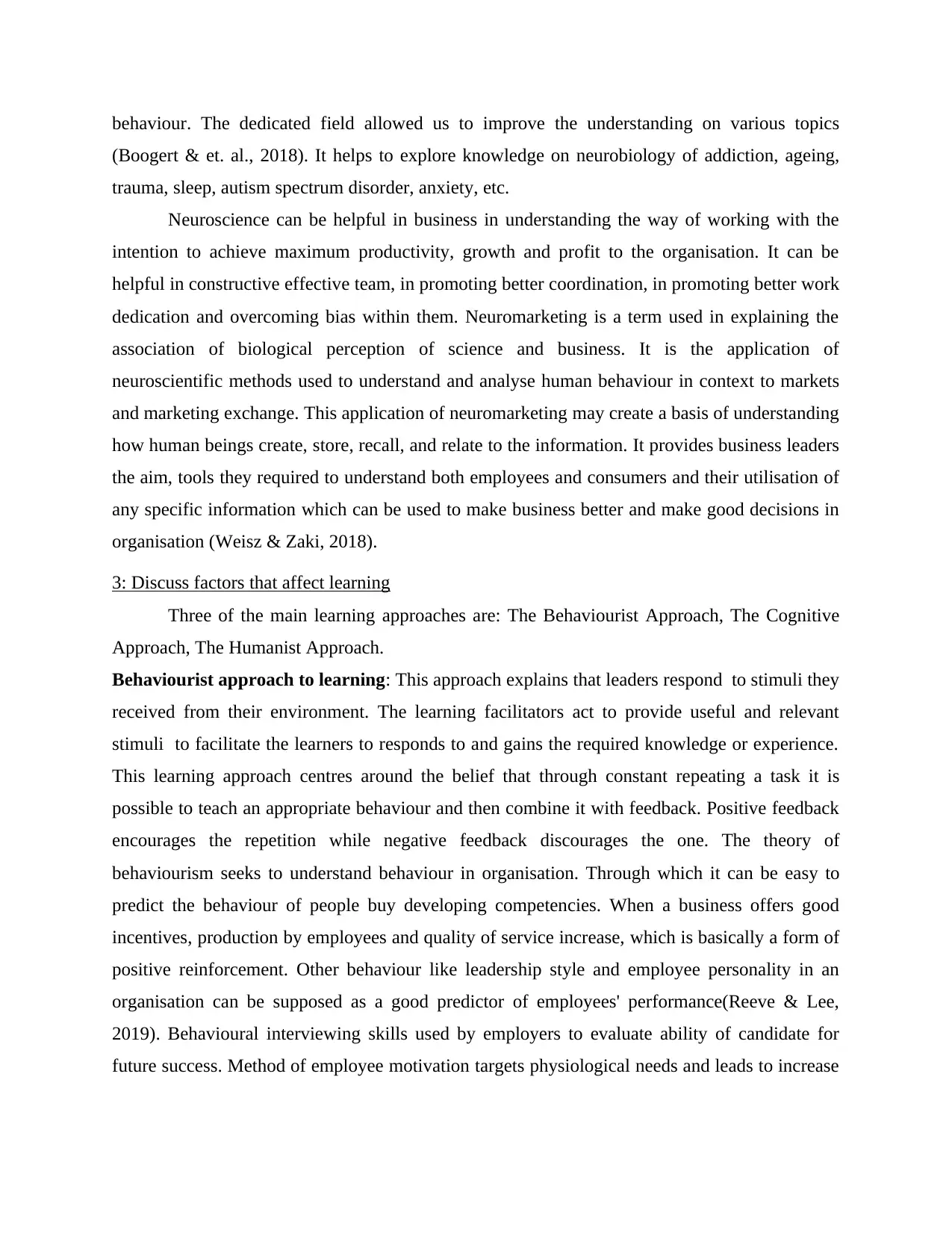
behaviour. The dedicated field allowed us to improve the understanding on various topics
(Boogert & et. al., 2018). It helps to explore knowledge on neurobiology of addiction, ageing,
trauma, sleep, autism spectrum disorder, anxiety, etc.
Neuroscience can be helpful in business in understanding the way of working with the
intention to achieve maximum productivity, growth and profit to the organisation. It can be
helpful in constructive effective team, in promoting better coordination, in promoting better work
dedication and overcoming bias within them. Neuromarketing is a term used in explaining the
association of biological perception of science and business. It is the application of
neuroscientific methods used to understand and analyse human behaviour in context to markets
and marketing exchange. This application of neuromarketing may create a basis of understanding
how human beings create, store, recall, and relate to the information. It provides business leaders
the aim, tools they required to understand both employees and consumers and their utilisation of
any specific information which can be used to make business better and make good decisions in
organisation (Weisz & Zaki, 2018).
3: Discuss factors that affect learning
Three of the main learning approaches are: The Behaviourist Approach, The Cognitive
Approach, The Humanist Approach.
Behaviourist approach to learning: This approach explains that leaders respond to stimuli they
received from their environment. The learning facilitators act to provide useful and relevant
stimuli to facilitate the learners to responds to and gains the required knowledge or experience.
This learning approach centres around the belief that through constant repeating a task it is
possible to teach an appropriate behaviour and then combine it with feedback. Positive feedback
encourages the repetition while negative feedback discourages the one. The theory of
behaviourism seeks to understand behaviour in organisation. Through which it can be easy to
predict the behaviour of people buy developing competencies. When a business offers good
incentives, production by employees and quality of service increase, which is basically a form of
positive reinforcement. Other behaviour like leadership style and employee personality in an
organisation can be supposed as a good predictor of employees' performance(Reeve & Lee,
2019). Behavioural interviewing skills used by employers to evaluate ability of candidate for
future success. Method of employee motivation targets physiological needs and leads to increase
(Boogert & et. al., 2018). It helps to explore knowledge on neurobiology of addiction, ageing,
trauma, sleep, autism spectrum disorder, anxiety, etc.
Neuroscience can be helpful in business in understanding the way of working with the
intention to achieve maximum productivity, growth and profit to the organisation. It can be
helpful in constructive effective team, in promoting better coordination, in promoting better work
dedication and overcoming bias within them. Neuromarketing is a term used in explaining the
association of biological perception of science and business. It is the application of
neuroscientific methods used to understand and analyse human behaviour in context to markets
and marketing exchange. This application of neuromarketing may create a basis of understanding
how human beings create, store, recall, and relate to the information. It provides business leaders
the aim, tools they required to understand both employees and consumers and their utilisation of
any specific information which can be used to make business better and make good decisions in
organisation (Weisz & Zaki, 2018).
3: Discuss factors that affect learning
Three of the main learning approaches are: The Behaviourist Approach, The Cognitive
Approach, The Humanist Approach.
Behaviourist approach to learning: This approach explains that leaders respond to stimuli they
received from their environment. The learning facilitators act to provide useful and relevant
stimuli to facilitate the learners to responds to and gains the required knowledge or experience.
This learning approach centres around the belief that through constant repeating a task it is
possible to teach an appropriate behaviour and then combine it with feedback. Positive feedback
encourages the repetition while negative feedback discourages the one. The theory of
behaviourism seeks to understand behaviour in organisation. Through which it can be easy to
predict the behaviour of people buy developing competencies. When a business offers good
incentives, production by employees and quality of service increase, which is basically a form of
positive reinforcement. Other behaviour like leadership style and employee personality in an
organisation can be supposed as a good predictor of employees' performance(Reeve & Lee,
2019). Behavioural interviewing skills used by employers to evaluate ability of candidate for
future success. Method of employee motivation targets physiological needs and leads to increase
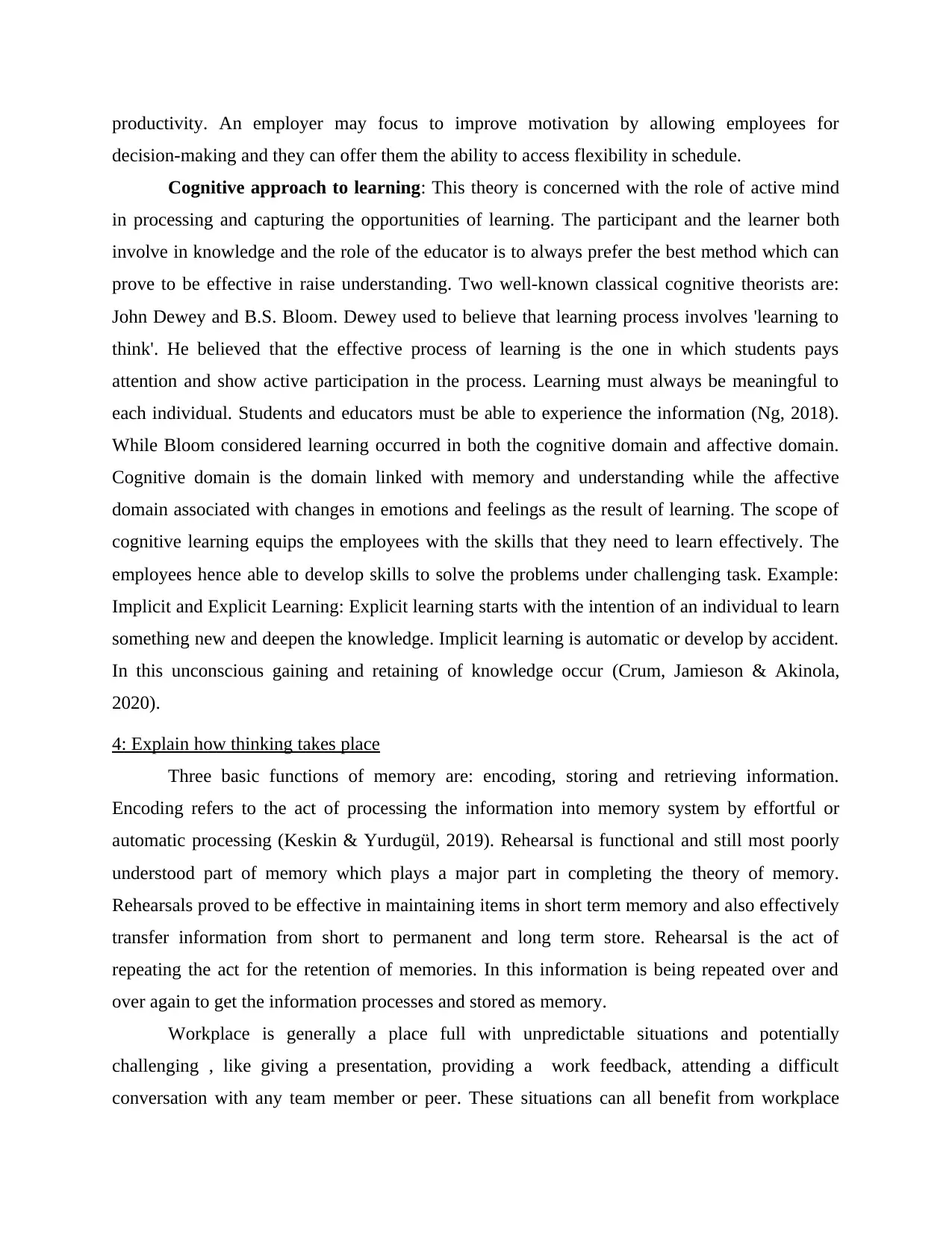
productivity. An employer may focus to improve motivation by allowing employees for
decision-making and they can offer them the ability to access flexibility in schedule.
Cognitive approach to learning: This theory is concerned with the role of active mind
in processing and capturing the opportunities of learning. The participant and the learner both
involve in knowledge and the role of the educator is to always prefer the best method which can
prove to be effective in raise understanding. Two well-known classical cognitive theorists are:
John Dewey and B.S. Bloom. Dewey used to believe that learning process involves 'learning to
think'. He believed that the effective process of learning is the one in which students pays
attention and show active participation in the process. Learning must always be meaningful to
each individual. Students and educators must be able to experience the information (Ng, 2018).
While Bloom considered learning occurred in both the cognitive domain and affective domain.
Cognitive domain is the domain linked with memory and understanding while the affective
domain associated with changes in emotions and feelings as the result of learning. The scope of
cognitive learning equips the employees with the skills that they need to learn effectively. The
employees hence able to develop skills to solve the problems under challenging task. Example:
Implicit and Explicit Learning: Explicit learning starts with the intention of an individual to learn
something new and deepen the knowledge. Implicit learning is automatic or develop by accident.
In this unconscious gaining and retaining of knowledge occur (Crum, Jamieson & Akinola,
2020).
4: Explain how thinking takes place
Three basic functions of memory are: encoding, storing and retrieving information.
Encoding refers to the act of processing the information into memory system by effortful or
automatic processing (Keskin & Yurdugül, 2019). Rehearsal is functional and still most poorly
understood part of memory which plays a major part in completing the theory of memory.
Rehearsals proved to be effective in maintaining items in short term memory and also effectively
transfer information from short to permanent and long term store. Rehearsal is the act of
repeating the act for the retention of memories. In this information is being repeated over and
over again to get the information processes and stored as memory.
Workplace is generally a place full with unpredictable situations and potentially
challenging , like giving a presentation, providing a work feedback, attending a difficult
conversation with any team member or peer. These situations can all benefit from workplace
decision-making and they can offer them the ability to access flexibility in schedule.
Cognitive approach to learning: This theory is concerned with the role of active mind
in processing and capturing the opportunities of learning. The participant and the learner both
involve in knowledge and the role of the educator is to always prefer the best method which can
prove to be effective in raise understanding. Two well-known classical cognitive theorists are:
John Dewey and B.S. Bloom. Dewey used to believe that learning process involves 'learning to
think'. He believed that the effective process of learning is the one in which students pays
attention and show active participation in the process. Learning must always be meaningful to
each individual. Students and educators must be able to experience the information (Ng, 2018).
While Bloom considered learning occurred in both the cognitive domain and affective domain.
Cognitive domain is the domain linked with memory and understanding while the affective
domain associated with changes in emotions and feelings as the result of learning. The scope of
cognitive learning equips the employees with the skills that they need to learn effectively. The
employees hence able to develop skills to solve the problems under challenging task. Example:
Implicit and Explicit Learning: Explicit learning starts with the intention of an individual to learn
something new and deepen the knowledge. Implicit learning is automatic or develop by accident.
In this unconscious gaining and retaining of knowledge occur (Crum, Jamieson & Akinola,
2020).
4: Explain how thinking takes place
Three basic functions of memory are: encoding, storing and retrieving information.
Encoding refers to the act of processing the information into memory system by effortful or
automatic processing (Keskin & Yurdugül, 2019). Rehearsal is functional and still most poorly
understood part of memory which plays a major part in completing the theory of memory.
Rehearsals proved to be effective in maintaining items in short term memory and also effectively
transfer information from short to permanent and long term store. Rehearsal is the act of
repeating the act for the retention of memories. In this information is being repeated over and
over again to get the information processes and stored as memory.
Workplace is generally a place full with unpredictable situations and potentially
challenging , like giving a presentation, providing a work feedback, attending a difficult
conversation with any team member or peer. These situations can all benefit from workplace
⊘ This is a preview!⊘
Do you want full access?
Subscribe today to unlock all pages.

Trusted by 1+ million students worldwide
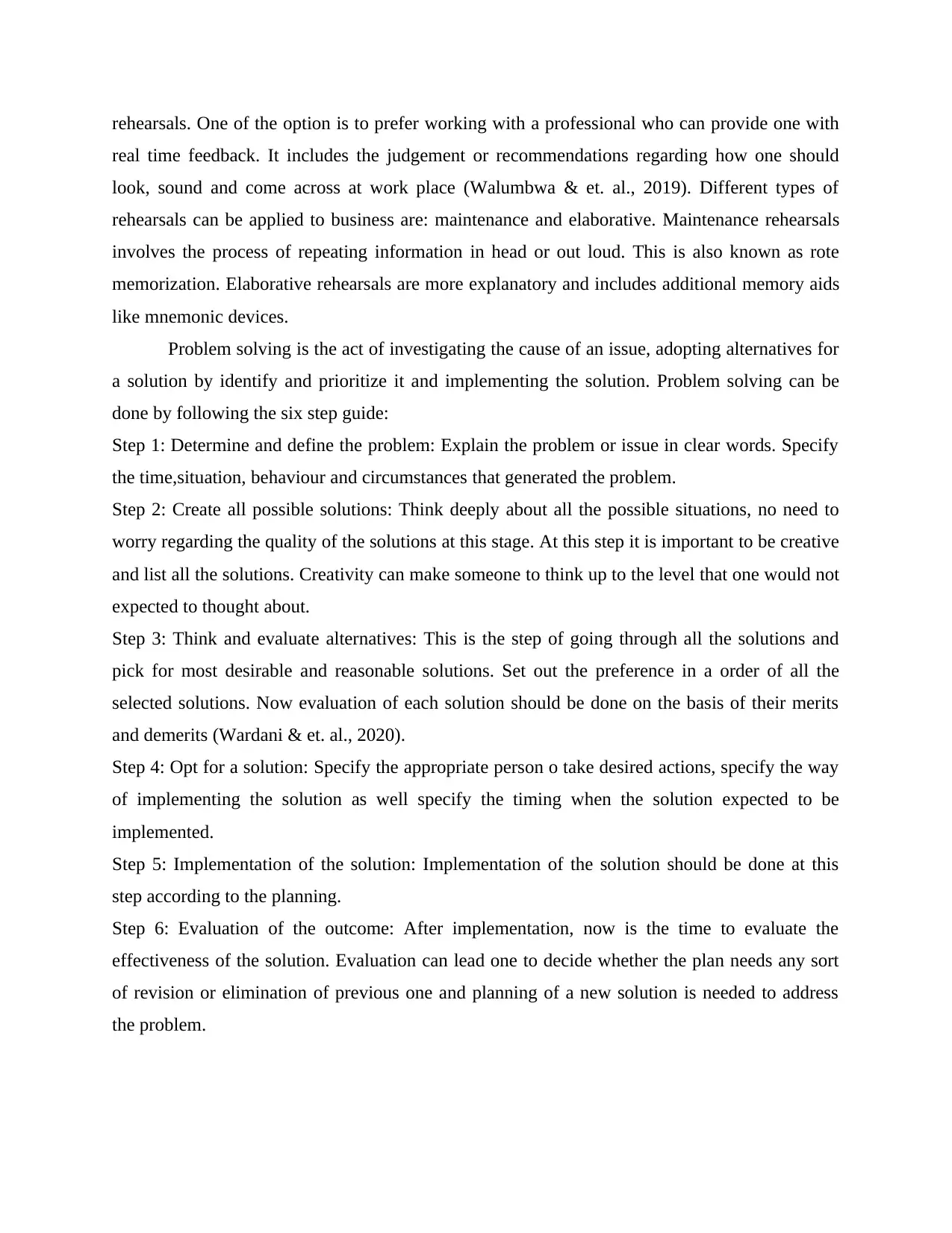
rehearsals. One of the option is to prefer working with a professional who can provide one with
real time feedback. It includes the judgement or recommendations regarding how one should
look, sound and come across at work place (Walumbwa & et. al., 2019). Different types of
rehearsals can be applied to business are: maintenance and elaborative. Maintenance rehearsals
involves the process of repeating information in head or out loud. This is also known as rote
memorization. Elaborative rehearsals are more explanatory and includes additional memory aids
like mnemonic devices.
Problem solving is the act of investigating the cause of an issue, adopting alternatives for
a solution by identify and prioritize it and implementing the solution. Problem solving can be
done by following the six step guide:
Step 1: Determine and define the problem: Explain the problem or issue in clear words. Specify
the time,situation, behaviour and circumstances that generated the problem.
Step 2: Create all possible solutions: Think deeply about all the possible situations, no need to
worry regarding the quality of the solutions at this stage. At this step it is important to be creative
and list all the solutions. Creativity can make someone to think up to the level that one would not
expected to thought about.
Step 3: Think and evaluate alternatives: This is the step of going through all the solutions and
pick for most desirable and reasonable solutions. Set out the preference in a order of all the
selected solutions. Now evaluation of each solution should be done on the basis of their merits
and demerits (Wardani & et. al., 2020).
Step 4: Opt for a solution: Specify the appropriate person o take desired actions, specify the way
of implementing the solution as well specify the timing when the solution expected to be
implemented.
Step 5: Implementation of the solution: Implementation of the solution should be done at this
step according to the planning.
Step 6: Evaluation of the outcome: After implementation, now is the time to evaluate the
effectiveness of the solution. Evaluation can lead one to decide whether the plan needs any sort
of revision or elimination of previous one and planning of a new solution is needed to address
the problem.
real time feedback. It includes the judgement or recommendations regarding how one should
look, sound and come across at work place (Walumbwa & et. al., 2019). Different types of
rehearsals can be applied to business are: maintenance and elaborative. Maintenance rehearsals
involves the process of repeating information in head or out loud. This is also known as rote
memorization. Elaborative rehearsals are more explanatory and includes additional memory aids
like mnemonic devices.
Problem solving is the act of investigating the cause of an issue, adopting alternatives for
a solution by identify and prioritize it and implementing the solution. Problem solving can be
done by following the six step guide:
Step 1: Determine and define the problem: Explain the problem or issue in clear words. Specify
the time,situation, behaviour and circumstances that generated the problem.
Step 2: Create all possible solutions: Think deeply about all the possible situations, no need to
worry regarding the quality of the solutions at this stage. At this step it is important to be creative
and list all the solutions. Creativity can make someone to think up to the level that one would not
expected to thought about.
Step 3: Think and evaluate alternatives: This is the step of going through all the solutions and
pick for most desirable and reasonable solutions. Set out the preference in a order of all the
selected solutions. Now evaluation of each solution should be done on the basis of their merits
and demerits (Wardani & et. al., 2020).
Step 4: Opt for a solution: Specify the appropriate person o take desired actions, specify the way
of implementing the solution as well specify the timing when the solution expected to be
implemented.
Step 5: Implementation of the solution: Implementation of the solution should be done at this
step according to the planning.
Step 6: Evaluation of the outcome: After implementation, now is the time to evaluate the
effectiveness of the solution. Evaluation can lead one to decide whether the plan needs any sort
of revision or elimination of previous one and planning of a new solution is needed to address
the problem.
Paraphrase This Document
Need a fresh take? Get an instant paraphrase of this document with our AI Paraphraser
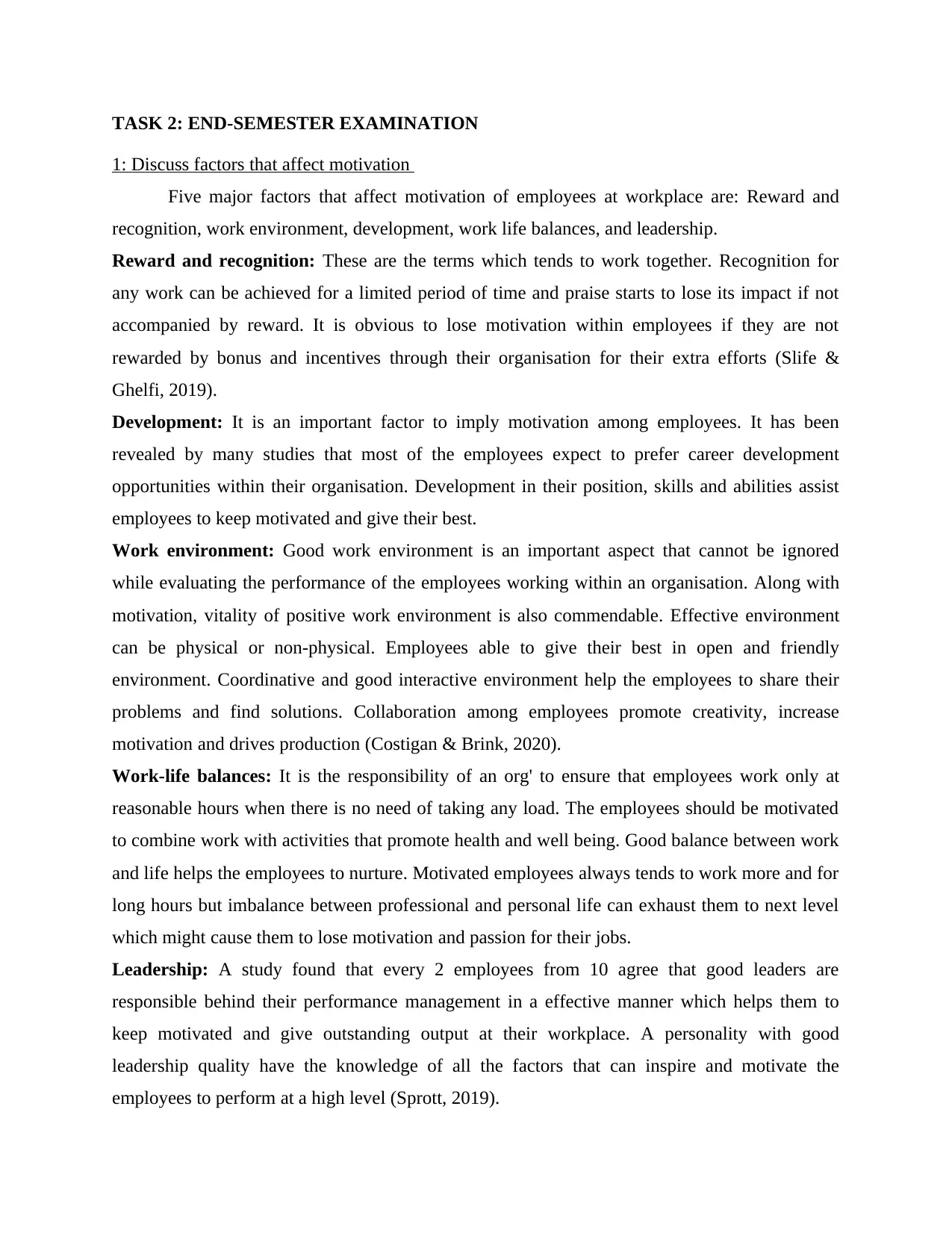
TASK 2: END-SEMESTER EXAMINATION
1: Discuss factors that affect motivation
Five major factors that affect motivation of employees at workplace are: Reward and
recognition, work environment, development, work life balances, and leadership.
Reward and recognition: These are the terms which tends to work together. Recognition for
any work can be achieved for a limited period of time and praise starts to lose its impact if not
accompanied by reward. It is obvious to lose motivation within employees if they are not
rewarded by bonus and incentives through their organisation for their extra efforts (Slife &
Ghelfi, 2019).
Development: It is an important factor to imply motivation among employees. It has been
revealed by many studies that most of the employees expect to prefer career development
opportunities within their organisation. Development in their position, skills and abilities assist
employees to keep motivated and give their best.
Work environment: Good work environment is an important aspect that cannot be ignored
while evaluating the performance of the employees working within an organisation. Along with
motivation, vitality of positive work environment is also commendable. Effective environment
can be physical or non-physical. Employees able to give their best in open and friendly
environment. Coordinative and good interactive environment help the employees to share their
problems and find solutions. Collaboration among employees promote creativity, increase
motivation and drives production (Costigan & Brink, 2020).
Work-life balances: It is the responsibility of an org' to ensure that employees work only at
reasonable hours when there is no need of taking any load. The employees should be motivated
to combine work with activities that promote health and well being. Good balance between work
and life helps the employees to nurture. Motivated employees always tends to work more and for
long hours but imbalance between professional and personal life can exhaust them to next level
which might cause them to lose motivation and passion for their jobs.
Leadership: A study found that every 2 employees from 10 agree that good leaders are
responsible behind their performance management in a effective manner which helps them to
keep motivated and give outstanding output at their workplace. A personality with good
leadership quality have the knowledge of all the factors that can inspire and motivate the
employees to perform at a high level (Sprott, 2019).
1: Discuss factors that affect motivation
Five major factors that affect motivation of employees at workplace are: Reward and
recognition, work environment, development, work life balances, and leadership.
Reward and recognition: These are the terms which tends to work together. Recognition for
any work can be achieved for a limited period of time and praise starts to lose its impact if not
accompanied by reward. It is obvious to lose motivation within employees if they are not
rewarded by bonus and incentives through their organisation for their extra efforts (Slife &
Ghelfi, 2019).
Development: It is an important factor to imply motivation among employees. It has been
revealed by many studies that most of the employees expect to prefer career development
opportunities within their organisation. Development in their position, skills and abilities assist
employees to keep motivated and give their best.
Work environment: Good work environment is an important aspect that cannot be ignored
while evaluating the performance of the employees working within an organisation. Along with
motivation, vitality of positive work environment is also commendable. Effective environment
can be physical or non-physical. Employees able to give their best in open and friendly
environment. Coordinative and good interactive environment help the employees to share their
problems and find solutions. Collaboration among employees promote creativity, increase
motivation and drives production (Costigan & Brink, 2020).
Work-life balances: It is the responsibility of an org' to ensure that employees work only at
reasonable hours when there is no need of taking any load. The employees should be motivated
to combine work with activities that promote health and well being. Good balance between work
and life helps the employees to nurture. Motivated employees always tends to work more and for
long hours but imbalance between professional and personal life can exhaust them to next level
which might cause them to lose motivation and passion for their jobs.
Leadership: A study found that every 2 employees from 10 agree that good leaders are
responsible behind their performance management in a effective manner which helps them to
keep motivated and give outstanding output at their workplace. A personality with good
leadership quality have the knowledge of all the factors that can inspire and motivate the
employees to perform at a high level (Sprott, 2019).
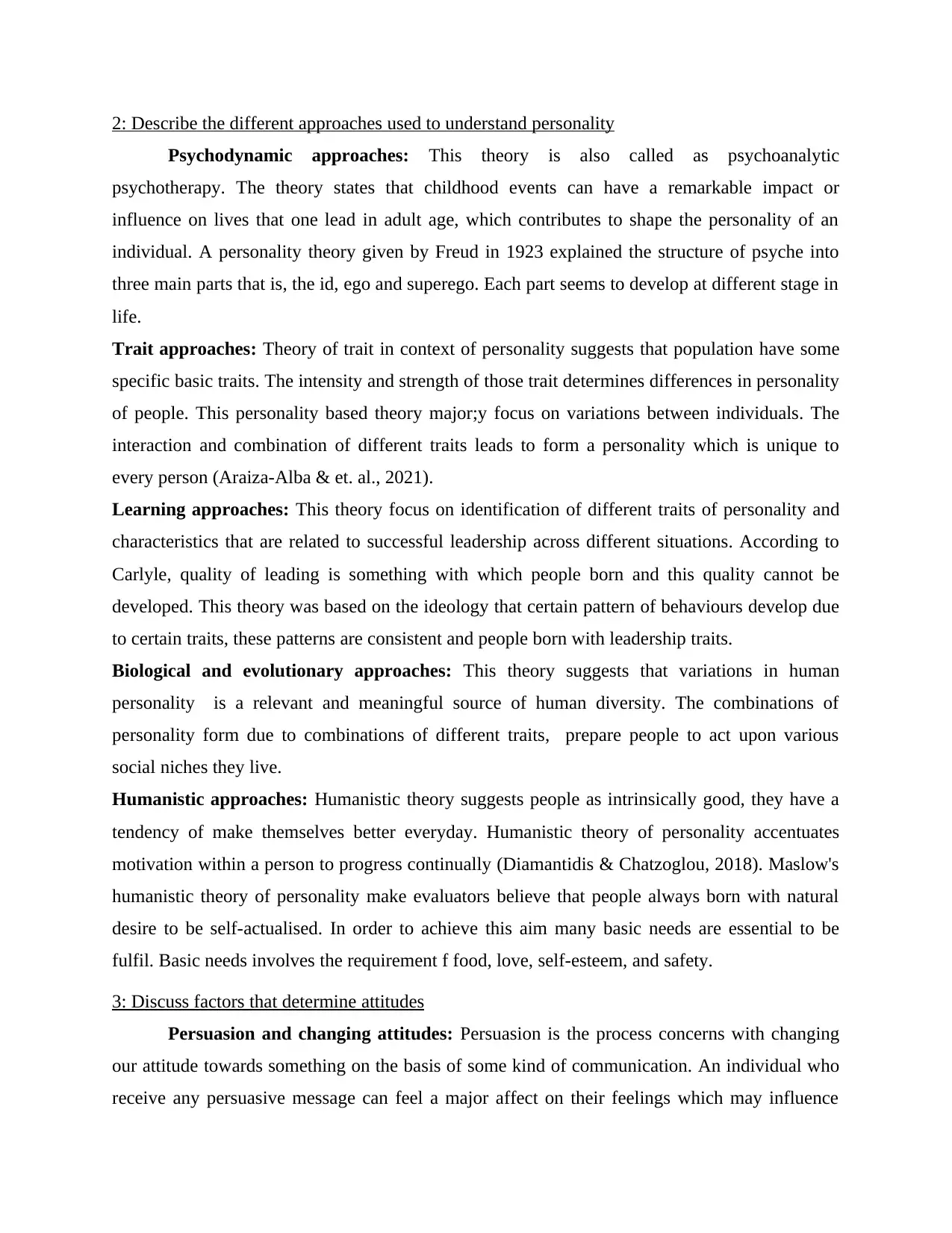
2: Describe the different approaches used to understand personality
Psychodynamic approaches: This theory is also called as psychoanalytic
psychotherapy. The theory states that childhood events can have a remarkable impact or
influence on lives that one lead in adult age, which contributes to shape the personality of an
individual. A personality theory given by Freud in 1923 explained the structure of psyche into
three main parts that is, the id, ego and superego. Each part seems to develop at different stage in
life.
Trait approaches: Theory of trait in context of personality suggests that population have some
specific basic traits. The intensity and strength of those trait determines differences in personality
of people. This personality based theory major;y focus on variations between individuals. The
interaction and combination of different traits leads to form a personality which is unique to
every person (Araiza-Alba & et. al., 2021).
Learning approaches: This theory focus on identification of different traits of personality and
characteristics that are related to successful leadership across different situations. According to
Carlyle, quality of leading is something with which people born and this quality cannot be
developed. This theory was based on the ideology that certain pattern of behaviours develop due
to certain traits, these patterns are consistent and people born with leadership traits.
Biological and evolutionary approaches: This theory suggests that variations in human
personality is a relevant and meaningful source of human diversity. The combinations of
personality form due to combinations of different traits, prepare people to act upon various
social niches they live.
Humanistic approaches: Humanistic theory suggests people as intrinsically good, they have a
tendency of make themselves better everyday. Humanistic theory of personality accentuates
motivation within a person to progress continually (Diamantidis & Chatzoglou, 2018). Maslow's
humanistic theory of personality make evaluators believe that people always born with natural
desire to be self-actualised. In order to achieve this aim many basic needs are essential to be
fulfil. Basic needs involves the requirement f food, love, self-esteem, and safety.
3: Discuss factors that determine attitudes
Persuasion and changing attitudes: Persuasion is the process concerns with changing
our attitude towards something on the basis of some kind of communication. An individual who
receive any persuasive message can feel a major affect on their feelings which may influence
Psychodynamic approaches: This theory is also called as psychoanalytic
psychotherapy. The theory states that childhood events can have a remarkable impact or
influence on lives that one lead in adult age, which contributes to shape the personality of an
individual. A personality theory given by Freud in 1923 explained the structure of psyche into
three main parts that is, the id, ego and superego. Each part seems to develop at different stage in
life.
Trait approaches: Theory of trait in context of personality suggests that population have some
specific basic traits. The intensity and strength of those trait determines differences in personality
of people. This personality based theory major;y focus on variations between individuals. The
interaction and combination of different traits leads to form a personality which is unique to
every person (Araiza-Alba & et. al., 2021).
Learning approaches: This theory focus on identification of different traits of personality and
characteristics that are related to successful leadership across different situations. According to
Carlyle, quality of leading is something with which people born and this quality cannot be
developed. This theory was based on the ideology that certain pattern of behaviours develop due
to certain traits, these patterns are consistent and people born with leadership traits.
Biological and evolutionary approaches: This theory suggests that variations in human
personality is a relevant and meaningful source of human diversity. The combinations of
personality form due to combinations of different traits, prepare people to act upon various
social niches they live.
Humanistic approaches: Humanistic theory suggests people as intrinsically good, they have a
tendency of make themselves better everyday. Humanistic theory of personality accentuates
motivation within a person to progress continually (Diamantidis & Chatzoglou, 2018). Maslow's
humanistic theory of personality make evaluators believe that people always born with natural
desire to be self-actualised. In order to achieve this aim many basic needs are essential to be
fulfil. Basic needs involves the requirement f food, love, self-esteem, and safety.
3: Discuss factors that determine attitudes
Persuasion and changing attitudes: Persuasion is the process concerns with changing
our attitude towards something on the basis of some kind of communication. An individual who
receive any persuasive message can feel a major affect on their feelings which may influence
⊘ This is a preview!⊘
Do you want full access?
Subscribe today to unlock all pages.

Trusted by 1+ million students worldwide
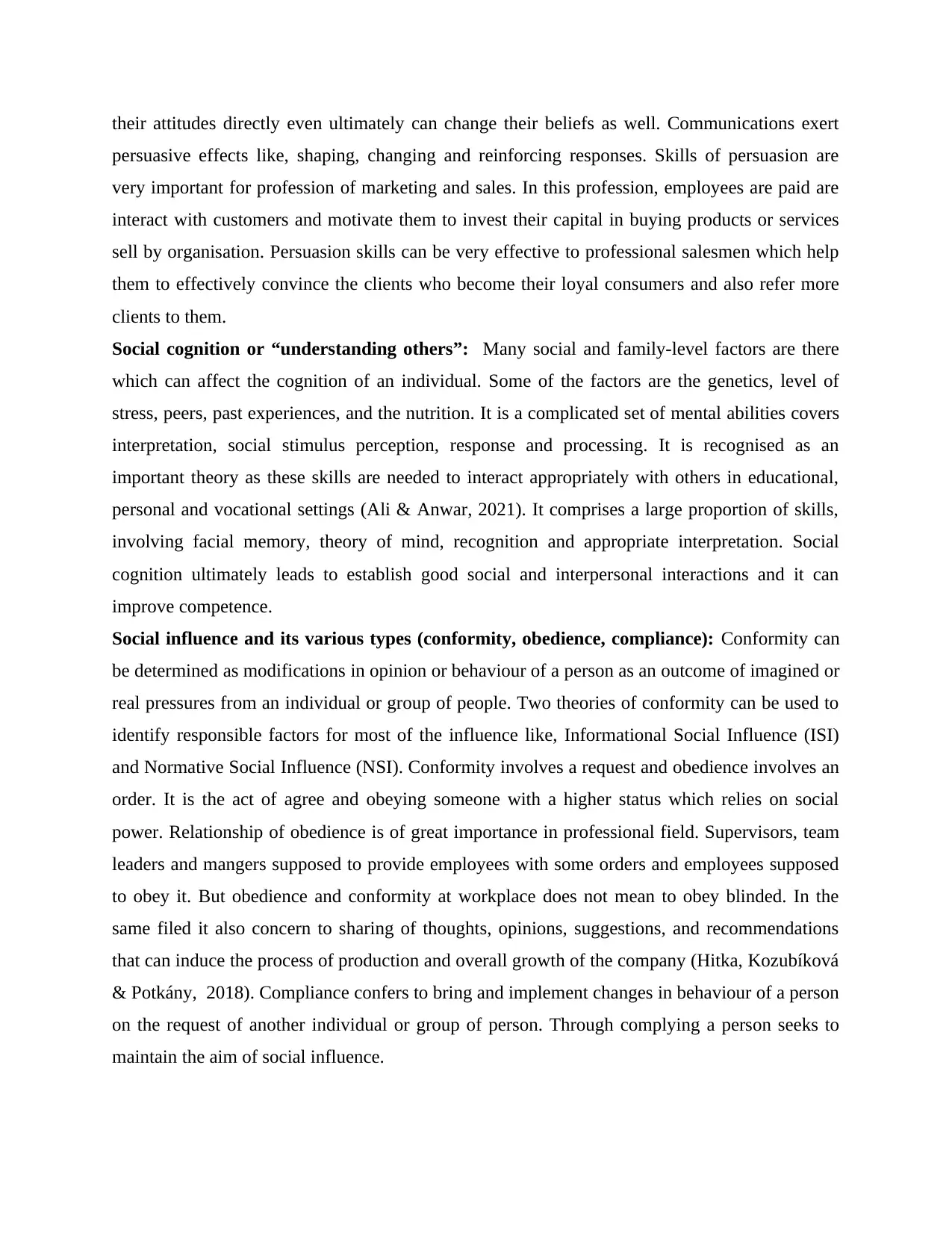
their attitudes directly even ultimately can change their beliefs as well. Communications exert
persuasive effects like, shaping, changing and reinforcing responses. Skills of persuasion are
very important for profession of marketing and sales. In this profession, employees are paid are
interact with customers and motivate them to invest their capital in buying products or services
sell by organisation. Persuasion skills can be very effective to professional salesmen which help
them to effectively convince the clients who become their loyal consumers and also refer more
clients to them.
Social cognition or “understanding others”: Many social and family-level factors are there
which can affect the cognition of an individual. Some of the factors are the genetics, level of
stress, peers, past experiences, and the nutrition. It is a complicated set of mental abilities covers
interpretation, social stimulus perception, response and processing. It is recognised as an
important theory as these skills are needed to interact appropriately with others in educational,
personal and vocational settings (Ali & Anwar, 2021). It comprises a large proportion of skills,
involving facial memory, theory of mind, recognition and appropriate interpretation. Social
cognition ultimately leads to establish good social and interpersonal interactions and it can
improve competence.
Social influence and its various types (conformity, obedience, compliance): Conformity can
be determined as modifications in opinion or behaviour of a person as an outcome of imagined or
real pressures from an individual or group of people. Two theories of conformity can be used to
identify responsible factors for most of the influence like, Informational Social Influence (ISI)
and Normative Social Influence (NSI). Conformity involves a request and obedience involves an
order. It is the act of agree and obeying someone with a higher status which relies on social
power. Relationship of obedience is of great importance in professional field. Supervisors, team
leaders and mangers supposed to provide employees with some orders and employees supposed
to obey it. But obedience and conformity at workplace does not mean to obey blinded. In the
same filed it also concern to sharing of thoughts, opinions, suggestions, and recommendations
that can induce the process of production and overall growth of the company (Hitka, Kozubíková
& Potkány, 2018). Compliance confers to bring and implement changes in behaviour of a person
on the request of another individual or group of person. Through complying a person seeks to
maintain the aim of social influence.
persuasive effects like, shaping, changing and reinforcing responses. Skills of persuasion are
very important for profession of marketing and sales. In this profession, employees are paid are
interact with customers and motivate them to invest their capital in buying products or services
sell by organisation. Persuasion skills can be very effective to professional salesmen which help
them to effectively convince the clients who become their loyal consumers and also refer more
clients to them.
Social cognition or “understanding others”: Many social and family-level factors are there
which can affect the cognition of an individual. Some of the factors are the genetics, level of
stress, peers, past experiences, and the nutrition. It is a complicated set of mental abilities covers
interpretation, social stimulus perception, response and processing. It is recognised as an
important theory as these skills are needed to interact appropriately with others in educational,
personal and vocational settings (Ali & Anwar, 2021). It comprises a large proportion of skills,
involving facial memory, theory of mind, recognition and appropriate interpretation. Social
cognition ultimately leads to establish good social and interpersonal interactions and it can
improve competence.
Social influence and its various types (conformity, obedience, compliance): Conformity can
be determined as modifications in opinion or behaviour of a person as an outcome of imagined or
real pressures from an individual or group of people. Two theories of conformity can be used to
identify responsible factors for most of the influence like, Informational Social Influence (ISI)
and Normative Social Influence (NSI). Conformity involves a request and obedience involves an
order. It is the act of agree and obeying someone with a higher status which relies on social
power. Relationship of obedience is of great importance in professional field. Supervisors, team
leaders and mangers supposed to provide employees with some orders and employees supposed
to obey it. But obedience and conformity at workplace does not mean to obey blinded. In the
same filed it also concern to sharing of thoughts, opinions, suggestions, and recommendations
that can induce the process of production and overall growth of the company (Hitka, Kozubíková
& Potkány, 2018). Compliance confers to bring and implement changes in behaviour of a person
on the request of another individual or group of person. Through complying a person seeks to
maintain the aim of social influence.
Paraphrase This Document
Need a fresh take? Get an instant paraphrase of this document with our AI Paraphraser
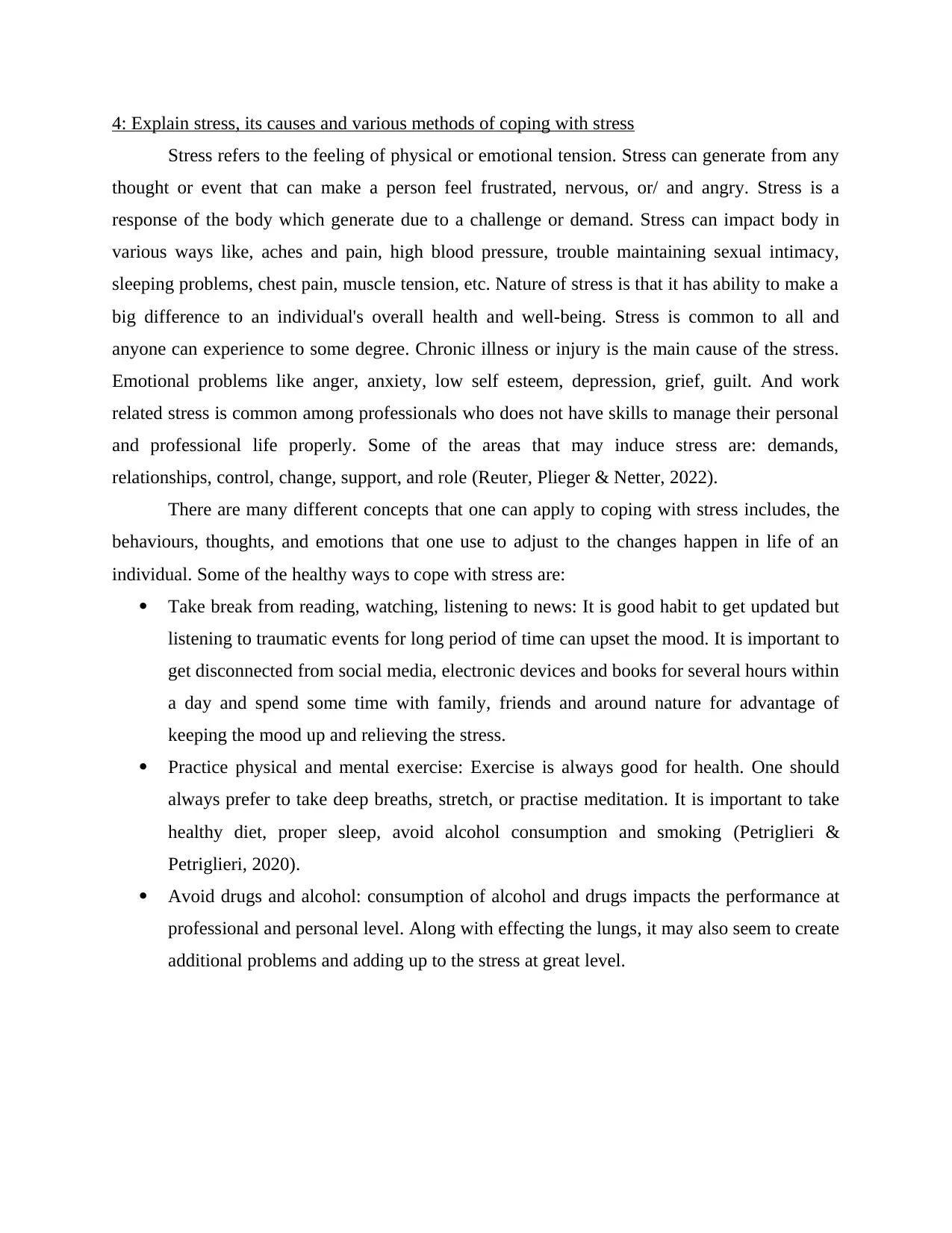
4: Explain stress, its causes and various methods of coping with stress
Stress refers to the feeling of physical or emotional tension. Stress can generate from any
thought or event that can make a person feel frustrated, nervous, or/ and angry. Stress is a
response of the body which generate due to a challenge or demand. Stress can impact body in
various ways like, aches and pain, high blood pressure, trouble maintaining sexual intimacy,
sleeping problems, chest pain, muscle tension, etc. Nature of stress is that it has ability to make a
big difference to an individual's overall health and well-being. Stress is common to all and
anyone can experience to some degree. Chronic illness or injury is the main cause of the stress.
Emotional problems like anger, anxiety, low self esteem, depression, grief, guilt. And work
related stress is common among professionals who does not have skills to manage their personal
and professional life properly. Some of the areas that may induce stress are: demands,
relationships, control, change, support, and role (Reuter, Plieger & Netter, 2022).
There are many different concepts that one can apply to coping with stress includes, the
behaviours, thoughts, and emotions that one use to adjust to the changes happen in life of an
individual. Some of the healthy ways to cope with stress are:
Take break from reading, watching, listening to news: It is good habit to get updated but
listening to traumatic events for long period of time can upset the mood. It is important to
get disconnected from social media, electronic devices and books for several hours within
a day and spend some time with family, friends and around nature for advantage of
keeping the mood up and relieving the stress.
Practice physical and mental exercise: Exercise is always good for health. One should
always prefer to take deep breaths, stretch, or practise meditation. It is important to take
healthy diet, proper sleep, avoid alcohol consumption and smoking (Petriglieri &
Petriglieri, 2020).
Avoid drugs and alcohol: consumption of alcohol and drugs impacts the performance at
professional and personal level. Along with effecting the lungs, it may also seem to create
additional problems and adding up to the stress at great level.
Stress refers to the feeling of physical or emotional tension. Stress can generate from any
thought or event that can make a person feel frustrated, nervous, or/ and angry. Stress is a
response of the body which generate due to a challenge or demand. Stress can impact body in
various ways like, aches and pain, high blood pressure, trouble maintaining sexual intimacy,
sleeping problems, chest pain, muscle tension, etc. Nature of stress is that it has ability to make a
big difference to an individual's overall health and well-being. Stress is common to all and
anyone can experience to some degree. Chronic illness or injury is the main cause of the stress.
Emotional problems like anger, anxiety, low self esteem, depression, grief, guilt. And work
related stress is common among professionals who does not have skills to manage their personal
and professional life properly. Some of the areas that may induce stress are: demands,
relationships, control, change, support, and role (Reuter, Plieger & Netter, 2022).
There are many different concepts that one can apply to coping with stress includes, the
behaviours, thoughts, and emotions that one use to adjust to the changes happen in life of an
individual. Some of the healthy ways to cope with stress are:
Take break from reading, watching, listening to news: It is good habit to get updated but
listening to traumatic events for long period of time can upset the mood. It is important to
get disconnected from social media, electronic devices and books for several hours within
a day and spend some time with family, friends and around nature for advantage of
keeping the mood up and relieving the stress.
Practice physical and mental exercise: Exercise is always good for health. One should
always prefer to take deep breaths, stretch, or practise meditation. It is important to take
healthy diet, proper sleep, avoid alcohol consumption and smoking (Petriglieri &
Petriglieri, 2020).
Avoid drugs and alcohol: consumption of alcohol and drugs impacts the performance at
professional and personal level. Along with effecting the lungs, it may also seem to create
additional problems and adding up to the stress at great level.
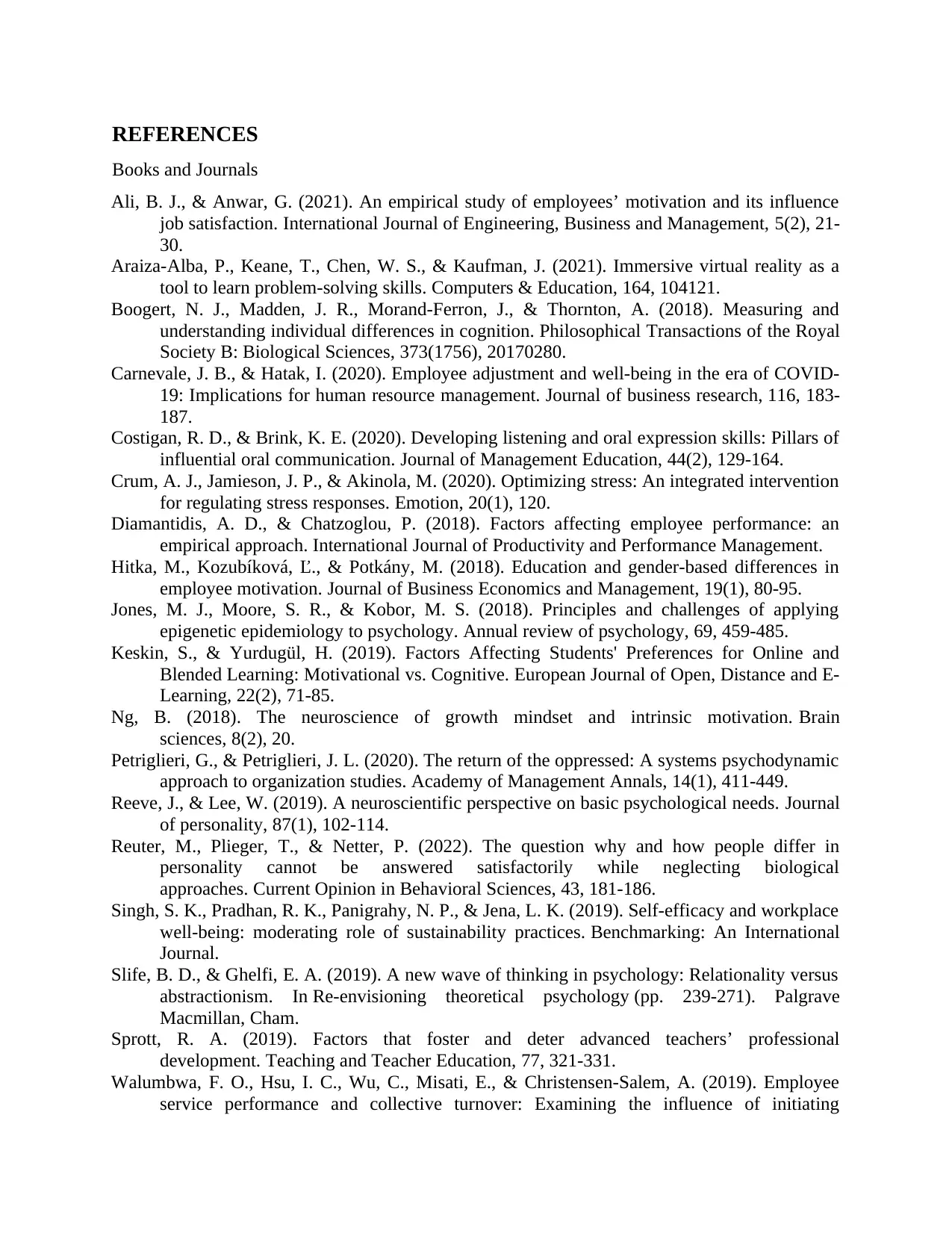
REFERENCES
Books and Journals
Ali, B. J., & Anwar, G. (2021). An empirical study of employees’ motivation and its influence
job satisfaction. International Journal of Engineering, Business and Management, 5(2), 21-
30.
Araiza-Alba, P., Keane, T., Chen, W. S., & Kaufman, J. (2021). Immersive virtual reality as a
tool to learn problem-solving skills. Computers & Education, 164, 104121.
Boogert, N. J., Madden, J. R., Morand-Ferron, J., & Thornton, A. (2018). Measuring and
understanding individual differences in cognition. Philosophical Transactions of the Royal
Society B: Biological Sciences, 373(1756), 20170280.
Carnevale, J. B., & Hatak, I. (2020). Employee adjustment and well-being in the era of COVID-
19: Implications for human resource management. Journal of business research, 116, 183-
187.
Costigan, R. D., & Brink, K. E. (2020). Developing listening and oral expression skills: Pillars of
influential oral communication. Journal of Management Education, 44(2), 129-164.
Crum, A. J., Jamieson, J. P., & Akinola, M. (2020). Optimizing stress: An integrated intervention
for regulating stress responses. Emotion, 20(1), 120.
Diamantidis, A. D., & Chatzoglou, P. (2018). Factors affecting employee performance: an
empirical approach. International Journal of Productivity and Performance Management.
Hitka, M., Kozubíková, Ľ., & Potkány, M. (2018). Education and gender-based differences in
employee motivation. Journal of Business Economics and Management, 19(1), 80-95.
Jones, M. J., Moore, S. R., & Kobor, M. S. (2018). Principles and challenges of applying
epigenetic epidemiology to psychology. Annual review of psychology, 69, 459-485.
Keskin, S., & Yurdugül, H. (2019). Factors Affecting Students' Preferences for Online and
Blended Learning: Motivational vs. Cognitive. European Journal of Open, Distance and E-
Learning, 22(2), 71-85.
Ng, B. (2018). The neuroscience of growth mindset and intrinsic motivation. Brain
sciences, 8(2), 20.
Petriglieri, G., & Petriglieri, J. L. (2020). The return of the oppressed: A systems psychodynamic
approach to organization studies. Academy of Management Annals, 14(1), 411-449.
Reeve, J., & Lee, W. (2019). A neuroscientific perspective on basic psychological needs. Journal
of personality, 87(1), 102-114.
Reuter, M., Plieger, T., & Netter, P. (2022). The question why and how people differ in
personality cannot be answered satisfactorily while neglecting biological
approaches. Current Opinion in Behavioral Sciences, 43, 181-186.
Singh, S. K., Pradhan, R. K., Panigrahy, N. P., & Jena, L. K. (2019). Self-efficacy and workplace
well-being: moderating role of sustainability practices. Benchmarking: An International
Journal.
Slife, B. D., & Ghelfi, E. A. (2019). A new wave of thinking in psychology: Relationality versus
abstractionism. In Re-envisioning theoretical psychology (pp. 239-271). Palgrave
Macmillan, Cham.
Sprott, R. A. (2019). Factors that foster and deter advanced teachers’ professional
development. Teaching and Teacher Education, 77, 321-331.
Walumbwa, F. O., Hsu, I. C., Wu, C., Misati, E., & Christensen-Salem, A. (2019). Employee
service performance and collective turnover: Examining the influence of initiating
Books and Journals
Ali, B. J., & Anwar, G. (2021). An empirical study of employees’ motivation and its influence
job satisfaction. International Journal of Engineering, Business and Management, 5(2), 21-
30.
Araiza-Alba, P., Keane, T., Chen, W. S., & Kaufman, J. (2021). Immersive virtual reality as a
tool to learn problem-solving skills. Computers & Education, 164, 104121.
Boogert, N. J., Madden, J. R., Morand-Ferron, J., & Thornton, A. (2018). Measuring and
understanding individual differences in cognition. Philosophical Transactions of the Royal
Society B: Biological Sciences, 373(1756), 20170280.
Carnevale, J. B., & Hatak, I. (2020). Employee adjustment and well-being in the era of COVID-
19: Implications for human resource management. Journal of business research, 116, 183-
187.
Costigan, R. D., & Brink, K. E. (2020). Developing listening and oral expression skills: Pillars of
influential oral communication. Journal of Management Education, 44(2), 129-164.
Crum, A. J., Jamieson, J. P., & Akinola, M. (2020). Optimizing stress: An integrated intervention
for regulating stress responses. Emotion, 20(1), 120.
Diamantidis, A. D., & Chatzoglou, P. (2018). Factors affecting employee performance: an
empirical approach. International Journal of Productivity and Performance Management.
Hitka, M., Kozubíková, Ľ., & Potkány, M. (2018). Education and gender-based differences in
employee motivation. Journal of Business Economics and Management, 19(1), 80-95.
Jones, M. J., Moore, S. R., & Kobor, M. S. (2018). Principles and challenges of applying
epigenetic epidemiology to psychology. Annual review of psychology, 69, 459-485.
Keskin, S., & Yurdugül, H. (2019). Factors Affecting Students' Preferences for Online and
Blended Learning: Motivational vs. Cognitive. European Journal of Open, Distance and E-
Learning, 22(2), 71-85.
Ng, B. (2018). The neuroscience of growth mindset and intrinsic motivation. Brain
sciences, 8(2), 20.
Petriglieri, G., & Petriglieri, J. L. (2020). The return of the oppressed: A systems psychodynamic
approach to organization studies. Academy of Management Annals, 14(1), 411-449.
Reeve, J., & Lee, W. (2019). A neuroscientific perspective on basic psychological needs. Journal
of personality, 87(1), 102-114.
Reuter, M., Plieger, T., & Netter, P. (2022). The question why and how people differ in
personality cannot be answered satisfactorily while neglecting biological
approaches. Current Opinion in Behavioral Sciences, 43, 181-186.
Singh, S. K., Pradhan, R. K., Panigrahy, N. P., & Jena, L. K. (2019). Self-efficacy and workplace
well-being: moderating role of sustainability practices. Benchmarking: An International
Journal.
Slife, B. D., & Ghelfi, E. A. (2019). A new wave of thinking in psychology: Relationality versus
abstractionism. In Re-envisioning theoretical psychology (pp. 239-271). Palgrave
Macmillan, Cham.
Sprott, R. A. (2019). Factors that foster and deter advanced teachers’ professional
development. Teaching and Teacher Education, 77, 321-331.
Walumbwa, F. O., Hsu, I. C., Wu, C., Misati, E., & Christensen-Salem, A. (2019). Employee
service performance and collective turnover: Examining the influence of initiating
⊘ This is a preview!⊘
Do you want full access?
Subscribe today to unlock all pages.

Trusted by 1+ million students worldwide
1 out of 14
Related Documents
Your All-in-One AI-Powered Toolkit for Academic Success.
+13062052269
info@desklib.com
Available 24*7 on WhatsApp / Email
![[object Object]](/_next/static/media/star-bottom.7253800d.svg)
Unlock your academic potential
Copyright © 2020–2025 A2Z Services. All Rights Reserved. Developed and managed by ZUCOL.




